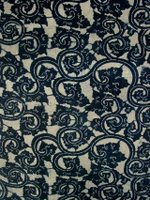
Indigo with a karakusa design that is dyed using the katazome (stencil technique) with rice paste resist.
Tuesday, November 22, 2005
INDGO FABRIC: Karakusa
Posted by
M. JOAN LINTAULT
at
4:16 PM
0
comments
![]()
INDIGO: Part 3
In Europe and the United States, paste was also used for dyeing with indigo in the 18th and 19th centuries. Its principal ingredient was kaolin mixed with wax, acids, gums and chemicals.
There are two basic methods for dyeing indigo. Indigo is insoluble in water and used by itself fabric cannot successfully be colored by indigo. The only way fabric can be dyed with indigo is through chemical reactions in the dye pot. There are two methods to immersion dye fabric with indigo. The first method is using a reduction vat. This method involves using caustic chemicals such as sodium hydrosulfite (a reducing agent) and sodium hydroxide (an alkali). The addition of these two chemicals causes all the oxygen in the dye pot to be removed. The rapid utilization of oxygen and its removal from the dye pot causes free hydrogen. This hydrogen combines with indigo. When the fabric is dipped into the dye pot the indigo migrates onto the fabric. The blue color develops only after the fabric has been removed from the dye pot. Exposed to the air, the oxygen again locks onto the hydrogen rendering the color insoluble once more. The chemicals for this type of vat are quite caustic and potentially dangerous. The dye pot should be outside or in a very well ventilated area,
The second method of indigo dyeing is a more benign method. In Japan indigo has been traditionally used in a fermentation vat. The Indigo plant is composted to remove the organic matter while preserving the dye. This composted plant matter is called sukumo. Sukumo has a high concentration of hydrogen producing bacteria necessary for fermentation. The indigo dyer only needs to provide "food" for the bacteria in the proper amount, at the proper time, at the proper temperature to make the dye work. Feeding the indigo dye pot is an art. Learning the skills to manage this type of vat can only be acquired by first hand experience. The konya-san (indigo-dyer) will use their fingers, eyes, nose and even the tip of their tongue to test the condition of the dye. The dye pot needs daily attention, constant temperature and takes on the aspect of a living being. The dye pot is often fed sake, oatmeal, or rice bran. In addition, an alkali leached from wood ashes is also added to the dye pot. Many things can go wrong to stop the process.
Posted by
M. JOAN LINTAULT
at
4:55 AM
0
comments
![]()





